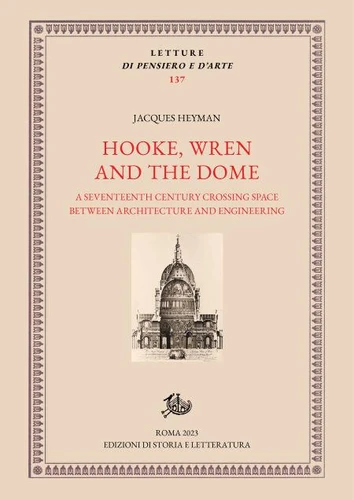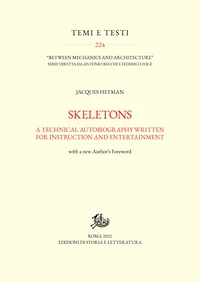Hooke, Wren and the Dome. A Seventeenth Century Crossing Space between Architecture and Engineering
Par : , ,Formats :
Disponible dans votre compte client Decitre ou Furet du Nord dès validation de votre commande. Le format PDF est :
- Compatible avec une lecture sur My Vivlio (smartphone, tablette, ordinateur)
- Compatible avec une lecture sur liseuses Vivlio
- Pour les liseuses autres que Vivlio, vous devez utiliser le logiciel Adobe Digital Edition. Non compatible avec la lecture sur les liseuses Kindle, Remarkable et Sony
 , qui est-ce ?
, qui est-ce ?Notre partenaire de plateforme de lecture numérique où vous retrouverez l'ensemble de vos ebooks gratuitement
Pour en savoir plus sur nos ebooks, consultez notre aide en ligne ici
- Nombre de pages100
- FormatPDF
- ISBN978-88-9359-815-6
- EAN9788893598156
- Date de parution23/11/2023
- Protection num.Digital Watermarking
- Taille8 Mo
- Infos supplémentairespdf
- ÉditeurEdizioni di Storia e Letteratu
Résumé
In the second half of the 17th century, new engineering science slowly began to contribute to architecture and to the structural analysis of vaults, arches and domes. Christopher Wren (1632-1723) and Robert Hooke (1635-1703) were both engaged in architecture and structural mechanics and Hooke's ideas played a crucial role in the design of the dome of St Paul's Cathedral in London. It was the first large dome built in England and became Wren's greatest architectural achievement.
In this book Professor Jacques Heyman, recipient of the Sir Frank Whittle Medal of the Royal Academy of Engineering (2022) and a leading figure in structural mechanics and history of engineering, describes the connections between the scientific contributions of Wren and Hooke in England and those of Giovanni Poleni (1683-1761) in Italy during the emergence of the modern professional architect and engineer.
Nella seconda metà del XVII secolo la nuova scienza degli ingegneri cominciò a dedicare una particolare attenzione all'analisi strutturale di archi, volte e cupole.
Christopher Wren (1632-1723) e Robert Hooke (1635-1703) si interessarono allo studio della meccanica applicata all'architettura e le idee di Hooke svolsero un ruolo cruciale nella definizione del progetto per la cupola della cattedrale di San Paolo a Londra. Essa divenne la prima grande cupola costruita in Inghilterra e la più importante realizzazione architettonica di Wren. In questo libro il Professor Jacques Heyman - uno dei maggiori esperti al mondo di meccanica strutturale e storia dell'ingegneria, insignito nel 2022 della Sir Frank Whittle Medal della Royal Academy of Engineering - descrive le connessioni tra le ricerche di Wren e Hooke in Inghilterra e quelle di Giovanni Poleni (1683-1761) in Italia, nel momento in cui architetti e ingegneri stavano ridefinendo i propri statuti professionali.
Christopher Wren (1632-1723) e Robert Hooke (1635-1703) si interessarono allo studio della meccanica applicata all'architettura e le idee di Hooke svolsero un ruolo cruciale nella definizione del progetto per la cupola della cattedrale di San Paolo a Londra. Essa divenne la prima grande cupola costruita in Inghilterra e la più importante realizzazione architettonica di Wren. In questo libro il Professor Jacques Heyman - uno dei maggiori esperti al mondo di meccanica strutturale e storia dell'ingegneria, insignito nel 2022 della Sir Frank Whittle Medal della Royal Academy of Engineering - descrive le connessioni tra le ricerche di Wren e Hooke in Inghilterra e quelle di Giovanni Poleni (1683-1761) in Italia, nel momento in cui architetti e ingegneri stavano ridefinendo i propri statuti professionali.
In the second half of the 17th century, new engineering science slowly began to contribute to architecture and to the structural analysis of vaults, arches and domes. Christopher Wren (1632-1723) and Robert Hooke (1635-1703) were both engaged in architecture and structural mechanics and Hooke's ideas played a crucial role in the design of the dome of St Paul's Cathedral in London. It was the first large dome built in England and became Wren's greatest architectural achievement.
In this book Professor Jacques Heyman, recipient of the Sir Frank Whittle Medal of the Royal Academy of Engineering (2022) and a leading figure in structural mechanics and history of engineering, describes the connections between the scientific contributions of Wren and Hooke in England and those of Giovanni Poleni (1683-1761) in Italy during the emergence of the modern professional architect and engineer.
Nella seconda metà del XVII secolo la nuova scienza degli ingegneri cominciò a dedicare una particolare attenzione all'analisi strutturale di archi, volte e cupole.
Christopher Wren (1632-1723) e Robert Hooke (1635-1703) si interessarono allo studio della meccanica applicata all'architettura e le idee di Hooke svolsero un ruolo cruciale nella definizione del progetto per la cupola della cattedrale di San Paolo a Londra. Essa divenne la prima grande cupola costruita in Inghilterra e la più importante realizzazione architettonica di Wren. In questo libro il Professor Jacques Heyman - uno dei maggiori esperti al mondo di meccanica strutturale e storia dell'ingegneria, insignito nel 2022 della Sir Frank Whittle Medal della Royal Academy of Engineering - descrive le connessioni tra le ricerche di Wren e Hooke in Inghilterra e quelle di Giovanni Poleni (1683-1761) in Italia, nel momento in cui architetti e ingegneri stavano ridefinendo i propri statuti professionali.
Christopher Wren (1632-1723) e Robert Hooke (1635-1703) si interessarono allo studio della meccanica applicata all'architettura e le idee di Hooke svolsero un ruolo cruciale nella definizione del progetto per la cupola della cattedrale di San Paolo a Londra. Essa divenne la prima grande cupola costruita in Inghilterra e la più importante realizzazione architettonica di Wren. In questo libro il Professor Jacques Heyman - uno dei maggiori esperti al mondo di meccanica strutturale e storia dell'ingegneria, insignito nel 2022 della Sir Frank Whittle Medal della Royal Academy of Engineering - descrive le connessioni tra le ricerche di Wren e Hooke in Inghilterra e quelle di Giovanni Poleni (1683-1761) in Italia, nel momento in cui architetti e ingegneri stavano ridefinendo i propri statuti professionali.




